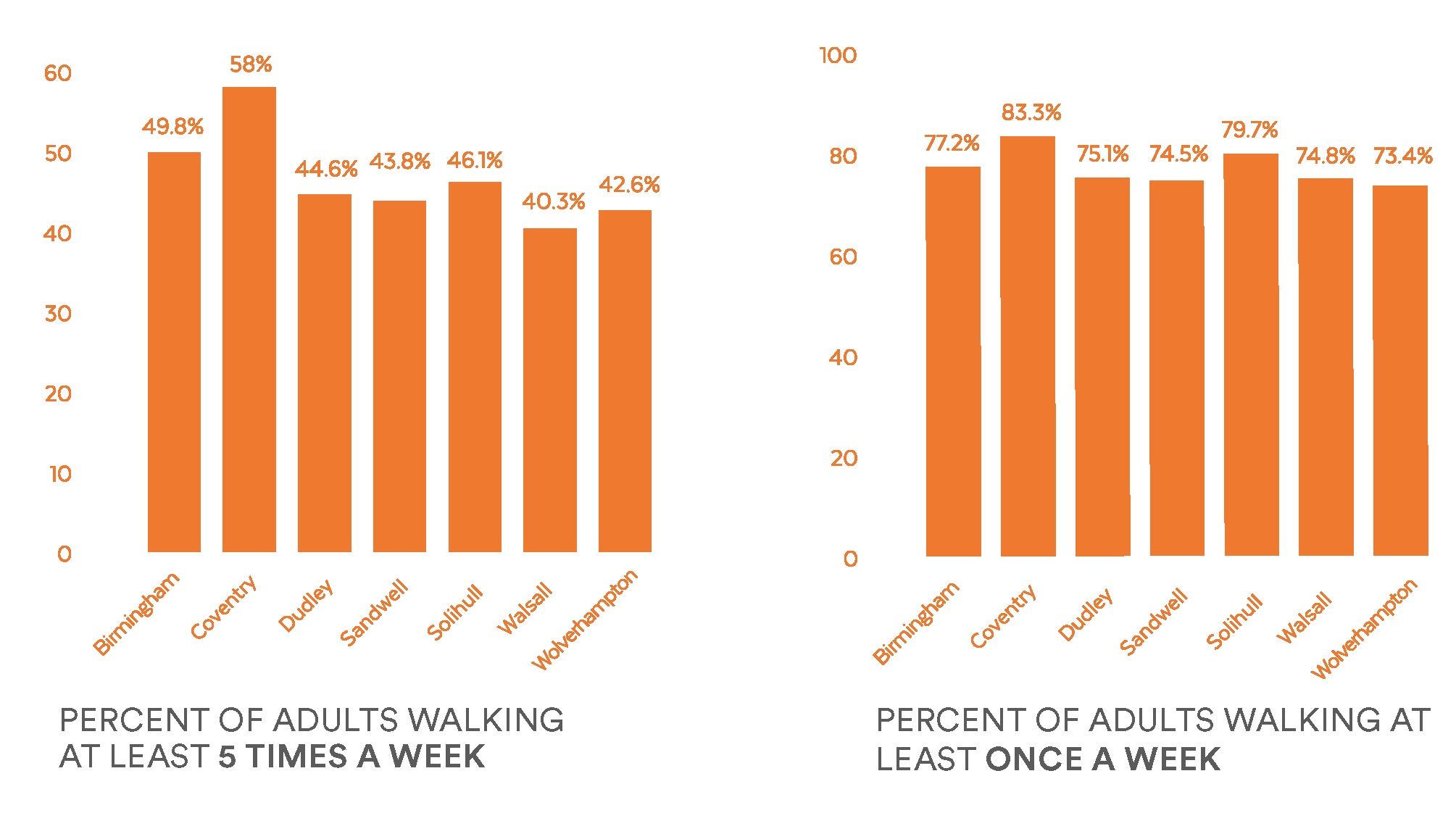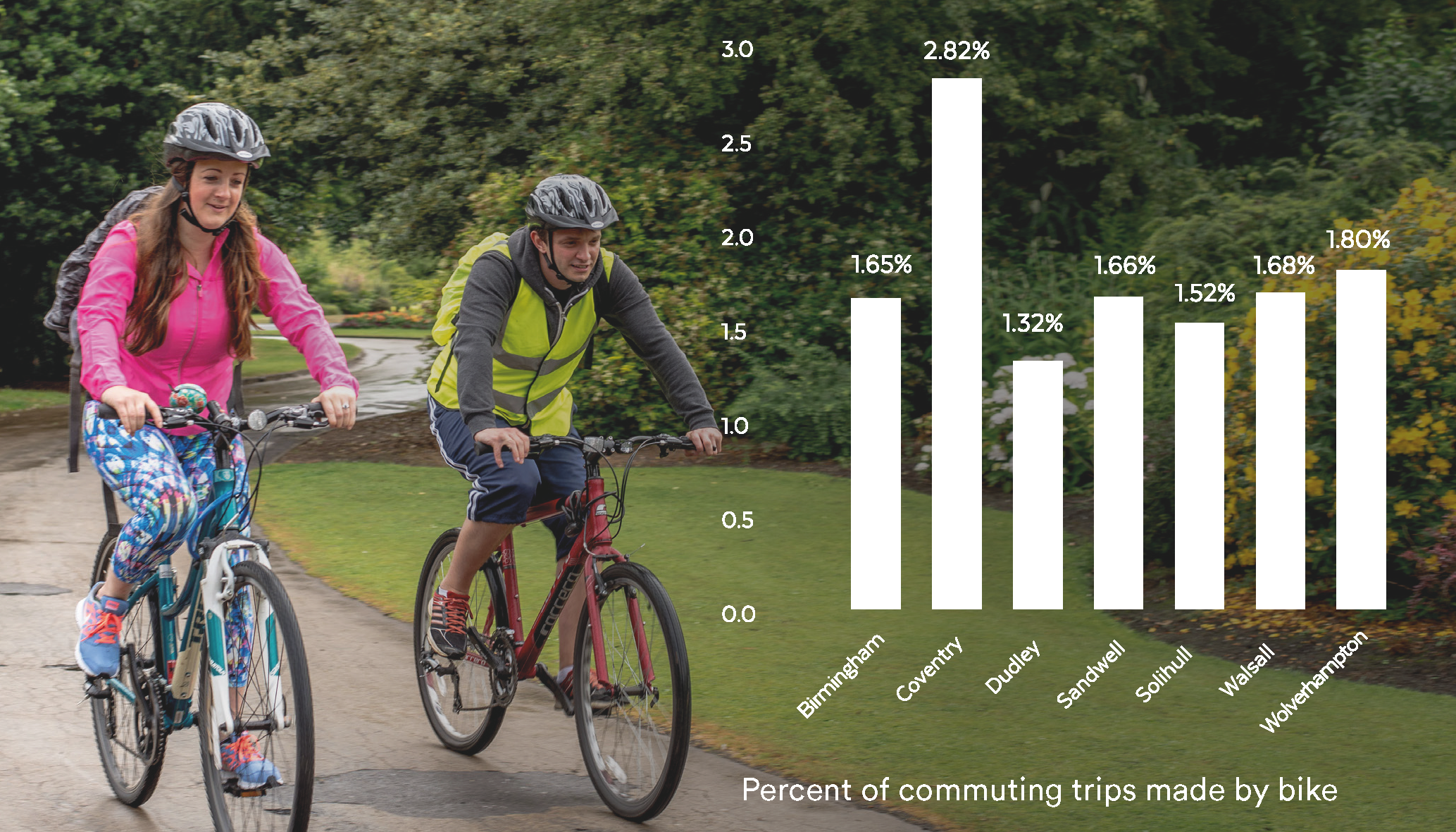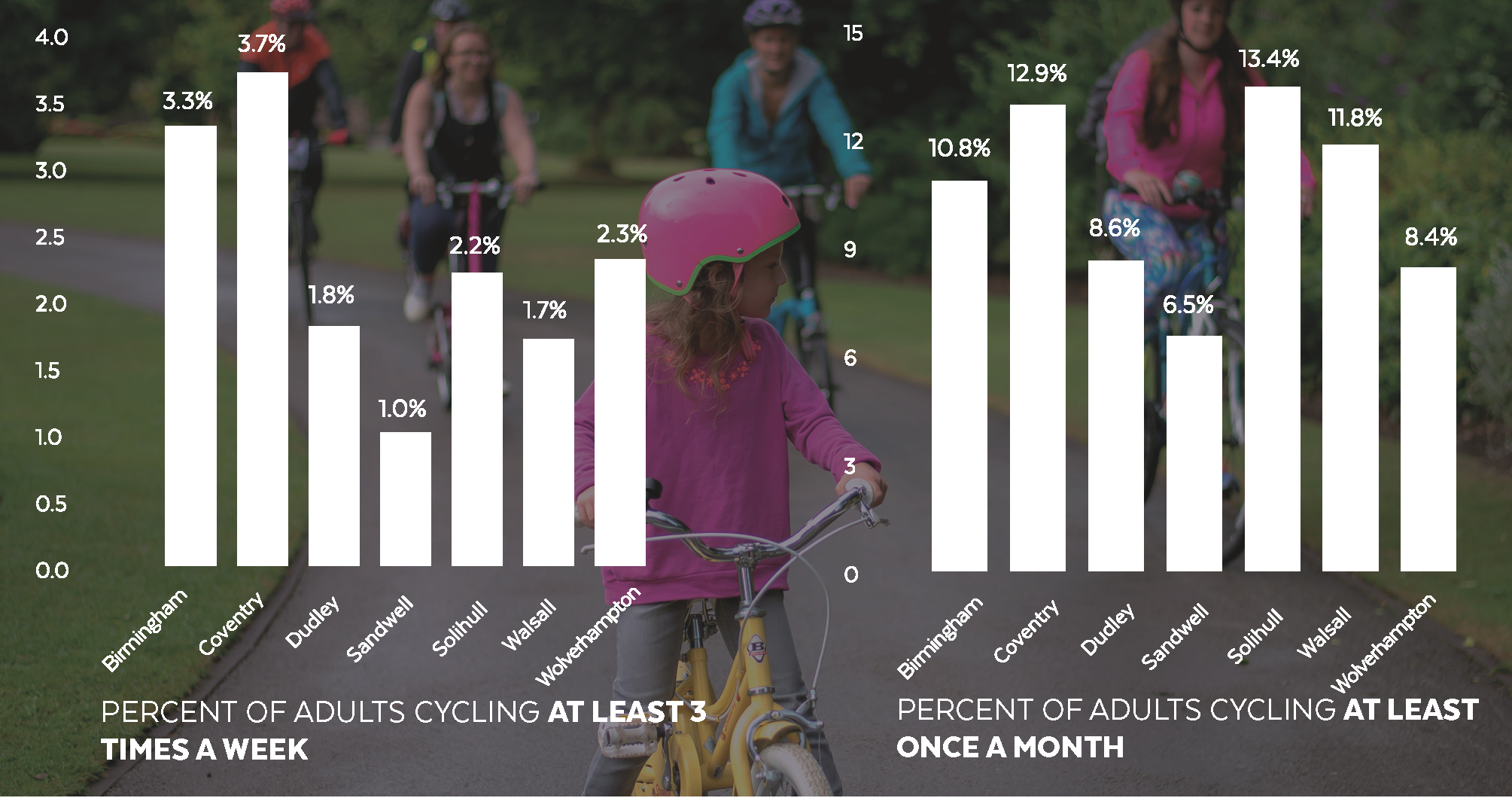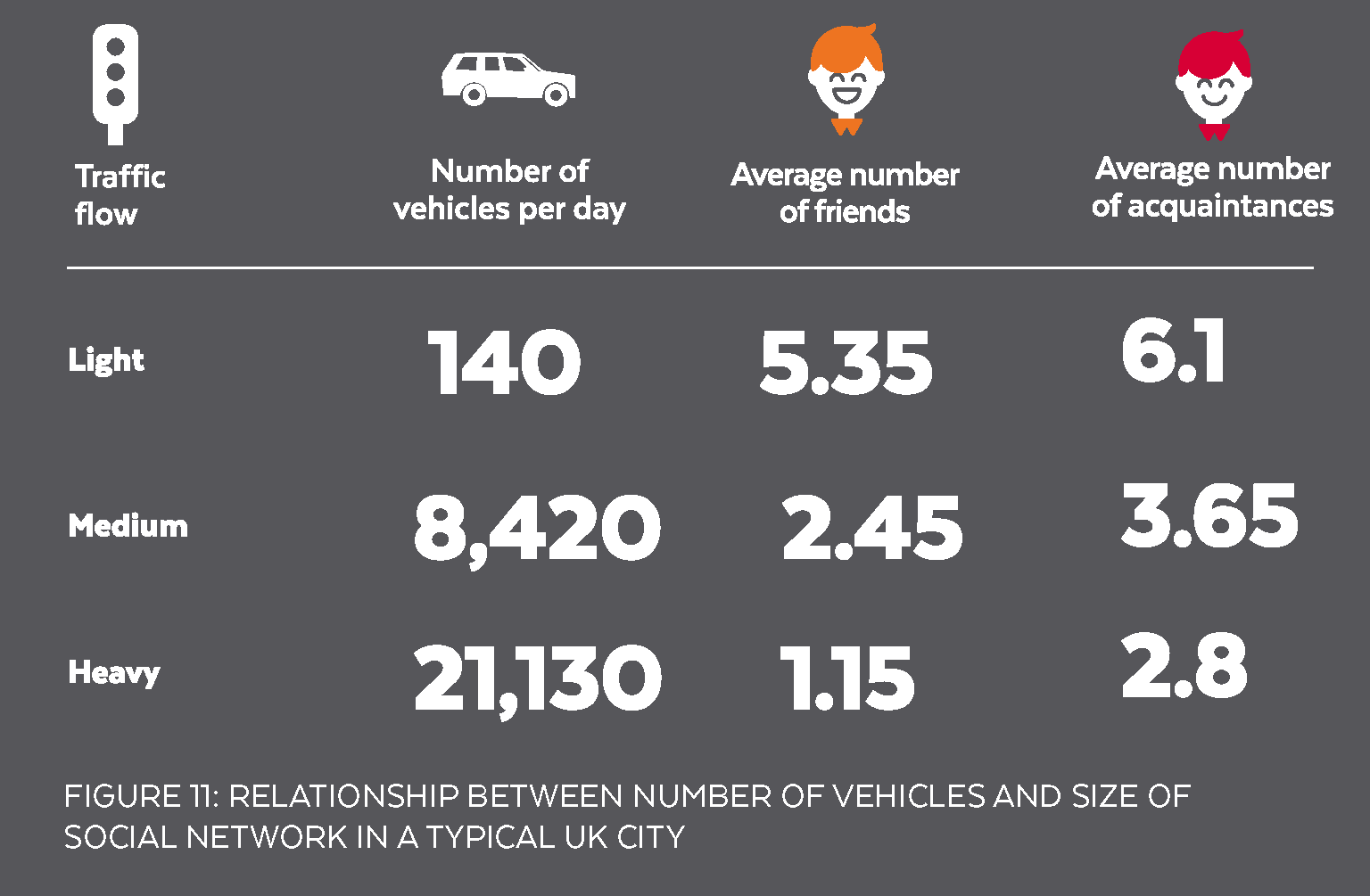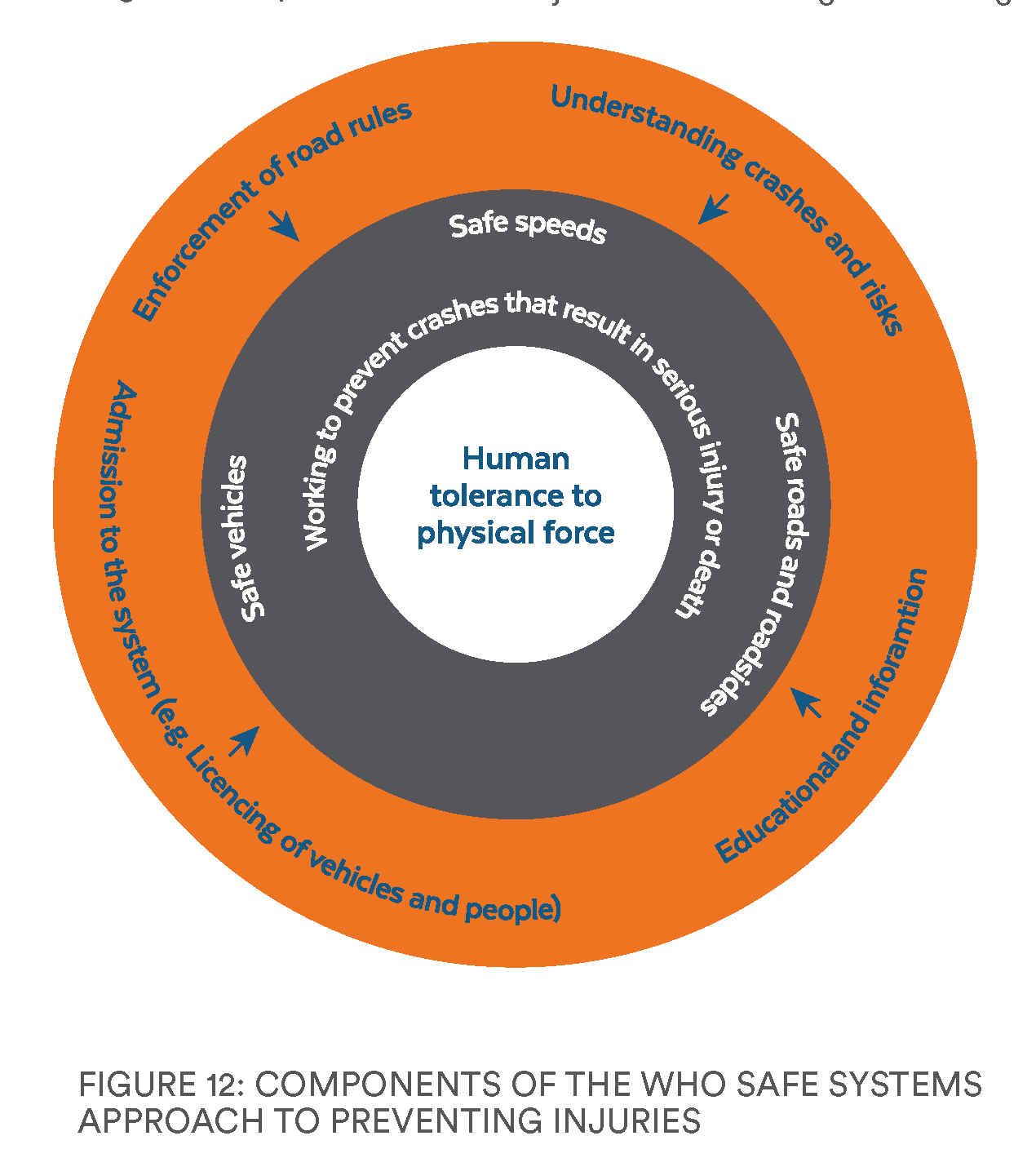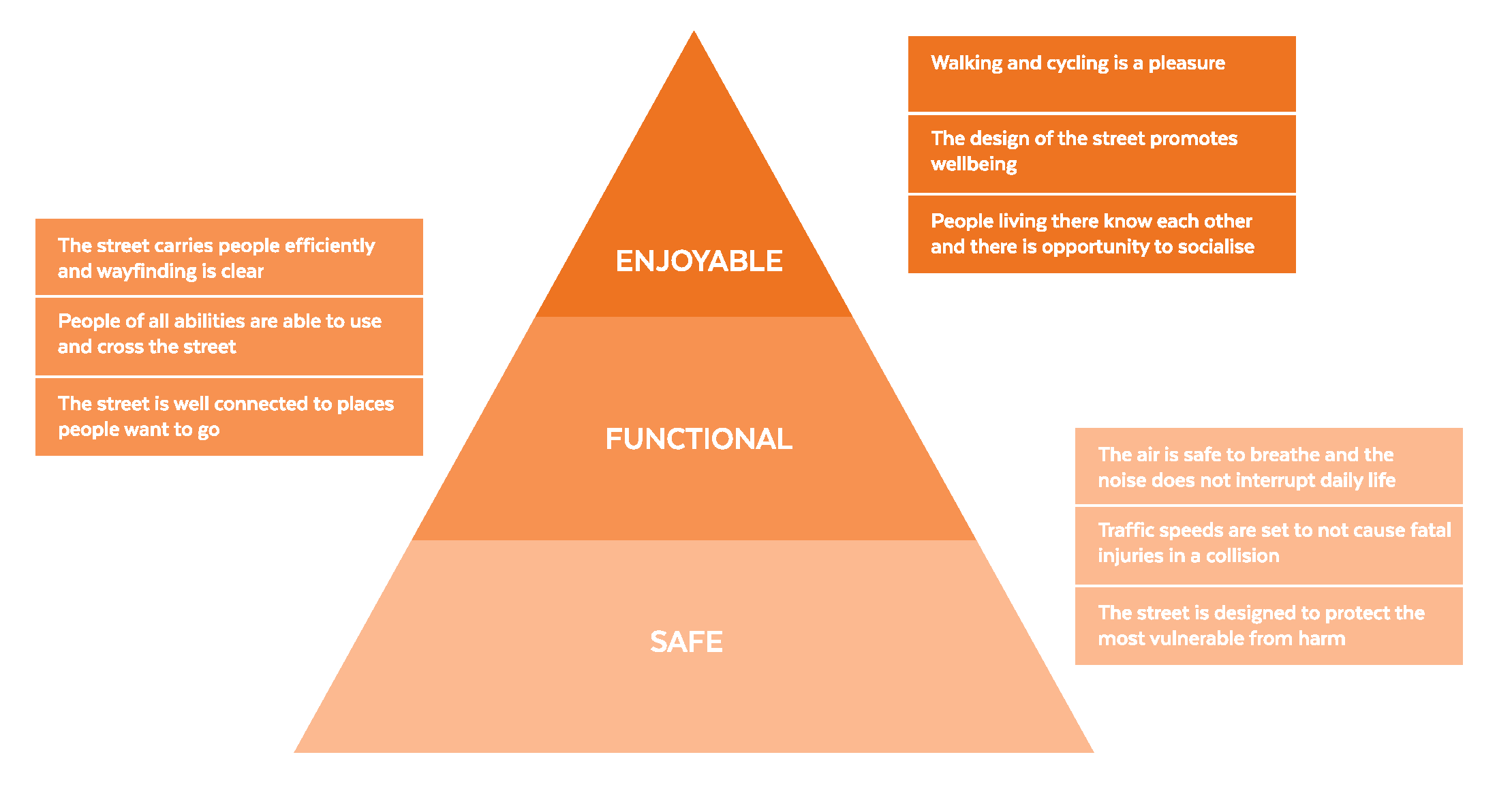
Movement For Growth
Health and Transport Strategy - Interactive Map
Summary
Map Key
West Midlands Area
Everyone travels or lives on streets. Where they are well designed with health and wellbeing goals in mind, they can be at the heart of cohesive and supportive communities. They can encourage physical activity by making it easier to walk and cycle, and have wider impacts on everyone’s health by reducing air pollution and increasing the feeling of safety.
Streets that make the West Midlands healthier and happier will also make it more economically active. Transport can play a large part in increasing productivity and reducing the demand for public services by preventing ill health and improving the wellbeing of people at work.
Life expectancies in the West Midlands have increased, ever since 2001, and in some areas men are expected to live to 80.4 years old and women 84.2 years old. However, recent years have seen a slow-down in the rate that they are increasing, and life expectancy in some parts of the West Midlands may even be decreasing.
Healthy life expectancies are lower still. The lowest male healthy life expectancy is in Wolverhampton where men are expected to live 56.4 years in good health. Similarly, in Walsall women are expected to live 59 years in good health.
There are also inequalities in health. Some of the more deprived areas within the West Midlands have even lower healthy life expectancies and people might only expect to live for 50 years in good health. This is a barrier to inclusive economic growth in the West Midlands.
Transport investment to improve health has a large impact. The number of people who might benefit from interventions can be large. Transport can improve health by several different ways, and where schemes are designed to address many of these the benefits can be maximised.
"Transport can play a large part in increasing productivity and reducing the demand for public services by preventing ill health and improving the wellbeing of people at work."

Cleaner Air
Map Key
Traffic conditions
Emissions of many pollutants have been falling since the 1970s, although the trend has slowed in recent years, the concentration of pollutants that people are exposed to has not fallen as quickly. This means that in the urban parts of the West Midlands, large numbers of people are living in areas of poor air quality and large amounts of traffic. This harm is more likely to fall on people living in deprived areas, who contribute fewer emissions to the problem.
Particulate matter is made up of small particles suspended in the air. It is caused by emissions from vehicle exhausts, but the wearing down of tyres, roads and brakes also contributes roughly the same amount of pollution. It is of importance because of the consistently strong evidence that it causes heart and lung disease, such as heart attacks or lung cancer. It can be particularly harmful to children and can cause early deaths, asthma, or developmental issues. The elderly are also more at risk, as well as people living with long term conditions.
Nitrogen dioxide is another harmful pollutant that can be caused by combustion in car engines, and it leads to increased amounts of heart or lung disease. In 2017 each of the constituent members of WMCA have a road above legal limits for this pollutant and both Birmingham and Coventry have been identified by DEFRA as local authorities that may still be above this limit by 2020, without further action.
Emissions
Map key
Average level of Particulate Matter
Industrial areas
Greenspace
Traffic conditions
Map Key
Average level of Nitrogen Dioxide
Industrial areas
Greenspace
Traffic conditions
Physical Activity
Map Key
Percentage of commuting trips made by bike
X.XX
"Physical activity has the greatest effect on health when people who would be otherwise inactive are enabled to become active. "
One of the most convenient ways for people to be physically active is to build it into their daily routine. This includes cycling and walking, and walking to and from public transport can also help people get enough physical activity during the week to have a protective effect. The Chief Medical Officer’s advice is to get 150 minutes of moderately intensive physical activity every week and people who cycle for transport are four times more likely to meet this.
In the West Midlands around 3 in every 10 people get less than 30 minutes of physical activity every week. 90,000 fewer people would be inactive if the physical activity rate could be increased to the England average. Physical inactivity is more common in the elderly, people in semi-routine or routine occupations and people with disabilities.
Physical inactivity has been linked with early deaths and the onset of many health conditions such as circulatory disease, type 2 diabetes, some cancers such as breast and colon, and depression. Even small increases of physical activity can have a big protective impact against ill health, especially amongst people who would otherwise be physically inactive. Because of the large impacts, increasing physical activity is an effective way to reduce short term sickness absences.
In 2011 around 1.8% of adults cycled to work and through the West Midlands Cycling Charter there is the ambition to increase this to 5% by 2023. There are many people who are more casual cyclists and around 10% of adults cycle at least once a month who might be encouraged to cycle more. There is a similar picture for walking. There is strong evidence that dedicated cycling infrastructure and improvements to make the streets feel safer can increase the amount of walking and cycling.
"In 2011 around 1.8% of adults cycled to work and through the Cycling Charter there is the ambition to increase this to 5% by 2023."
Travel to work
Travel to work by Foot
What does the data show?
This shows the percentage of people in an area who typically walk to work.
Where is the data from?
Commuting information was collected through the national census in 2011.
What is it measured in?
Percentage of the population
Map Key
Footpaths
Percentage of the population who are walking to work
Travel to work by Bicycle
What does the data show?
This shows the percentage of people in an area who typically cycle to work.
Where is the data from?
Commuting information was collected through the national census in 2011.
What is it measured in?
Percentage of the population who are cycling to work.
Map Key
Cycle Routes
Percentage of the population
Travel to work by Rail
What does the data show?
This shows the percentage of people in an area who typically travel by train to work.
Where is the data from?
Commuting information was collected through the national census in 2011.
What is it measured in?
Percentage of the population who are using the train to get to work.
Map Key
Footpaths
Percentage of the population who are walking to work
Mental wellbeing and social cohesion
Map Key
Percentage of the people requiring support for depression
‘Thrive West Midlands: an Action Plan for change’, sets out the ambition to improve mental wellbeing in the West Midlands and reduce the impact that poor mental health can have on people’s lives. It is estimated that over 200,000 adults in the West Midlands aged between 16-74 have either a mixed anxiety or depressive disorder at any one time. There would be 30,000 fewer if the CA average was the same as the average across the whole of England.
There are mental health benefits from reducing transport related noise and injury, and improving physical activity and perceived safety. The design of the transport system and street environment can also directly influence wellbeing.
Safer Streets
Map Key
20 Mph speed limits
Most of the West Midlands has lower injury rates than England, however, this is not necessarily true of all groups and children are more at risk of serious or fatal injury. Children living in more deprived areas are 4 times more at risk of being seriously injured or killed than children living in the more affluent areas. In part this is because of more unsafe roads and larger amounts of walking.nSeveral countries have taken the ethical position that streets should be designed so that a human error that causes a driver to hit a pedestrian is unlikely to lead to a death. This is known as a ‘safe systems’ approach and countries that have adopted this provide dedicated infrastructure for cyclists and pedestrians on high speed roads and reduce vehicle speeds in areas where this cannot be provided. Vehicle speeds of around 20mph are unlikely to kill pedestrians in a collision and many local authorities in the West Midlands are introducing 20mph speed limits across wide areas.
If hit at 20mph, out of every 200 pedrestrians will be killed. At speeds of 30mph, the risk of death is around 1 in ten.
85% of serious and fatal child pedrestrian injuries occur on roads with 30mph limits.
Location of KSI (Killed or seriously injured) collision
What does the data show?
This shows the location of where police reported serious or fatal collisions.
Where is the data from?
Various police data sources
What is it measured in?
The number of incidents reported in each area.
Map Key
Number of incidents reported
Number of reports of Killed or seriously injured
XXX
What does the data show?
This shows the location of where police reported serious or fatal collisions.
Where is the data from?
Various police data sources
What is it measured in?
The number of incidents reported in each area.
Map Key
Number of incidents reported
What does the data show?
This shows the location of where police reported serious or fatal collisions.
Where is the data from?
Various police data sources
What is it measured in?
The number of vehicles involved in each collision.
Map Key
Serious
Fatal
Noise
What does the data show?
This shows the average levels of noise pollution at night time over a year. Noise pollution may be higher or lower at different times during the night.
Where is the data from?
Night time noise levels were modelled by Defra in 2012.
What is it measured in?
Decibel meter reading with 0 dBA being the softest level that a person can hear. The higher the figure, the louder the noise.
Map Key
Decibel meter reading
Health and Wellbeing within the West Midlands
Map Key
Average Male & Female Healthy life expectancy
X.XX
Life expectancy describes how old an average person in an area can expect to live and can be used to describe the health of an area, as lower life expectancies suggest that ill health causes people to die earlier. In England, the life expectancy for men at birth is 79.5 years old. On average, women tend to live longer and female life expectancy at birth is 83.1 years old in England.
Six of the seven local authorities in the West Midlands have lower life expectancies at birth than England. The lowest male life expectancies are 77.1 years in Birmingham and Sandwell, compared with the highest of 80.4 years in Solihull. There is variation in female life expectancies, and in it is 81.3 years old in Wolverhampton compared against 84.2 years in Solihull. The differences of several years show that some areas of the West Midlands are in poorer health.
Life expectancies for both men and women have increased across all the West Midlands since 2001- 2003. There is some evidence that since at least 2011-13 life expectancies have not increased as quickly.
There are differences in healthy life expectancy at birth within the West Midlands. In Wolverhampton, the healthy life expectancy for men is 56.4 years, compared against 63.8 years in Solihull. Women generally have higher healthy life expectancies and amongst women the lowest healthy life expectancy is 59 years in Walsall and the highest is 67.9 years in Solihull.
Local authorities with lower life expectancy typically also have higher rates of unemployment and more people with long term sickness and disability. In areas of low healthy life expectancy over half of men aged 25 to 64 who are out of work and not seeking work have long term illnesses.
There is a connection between healthy life expectancy and skills. Fewer people in areas of low healthy life expectancy have a qualification of NQF Level 4 and above. However, people with similar educational levels were more likely to report better health in areas of higher healthy life expectancy.
Healthy Life Expectancy
Male Life Expectancy
What does the data show?
This shows how old an average man might expect to live in good health, in a given area.
Where is the data from?
Healthy life expectancies were calculated based on 2009 to 2013 data, and were published by ONS in 2015.
What is it measured in?
Average age ranges a man might expect to live in good health in a given area.
Map Key
Healthy life expectancy age
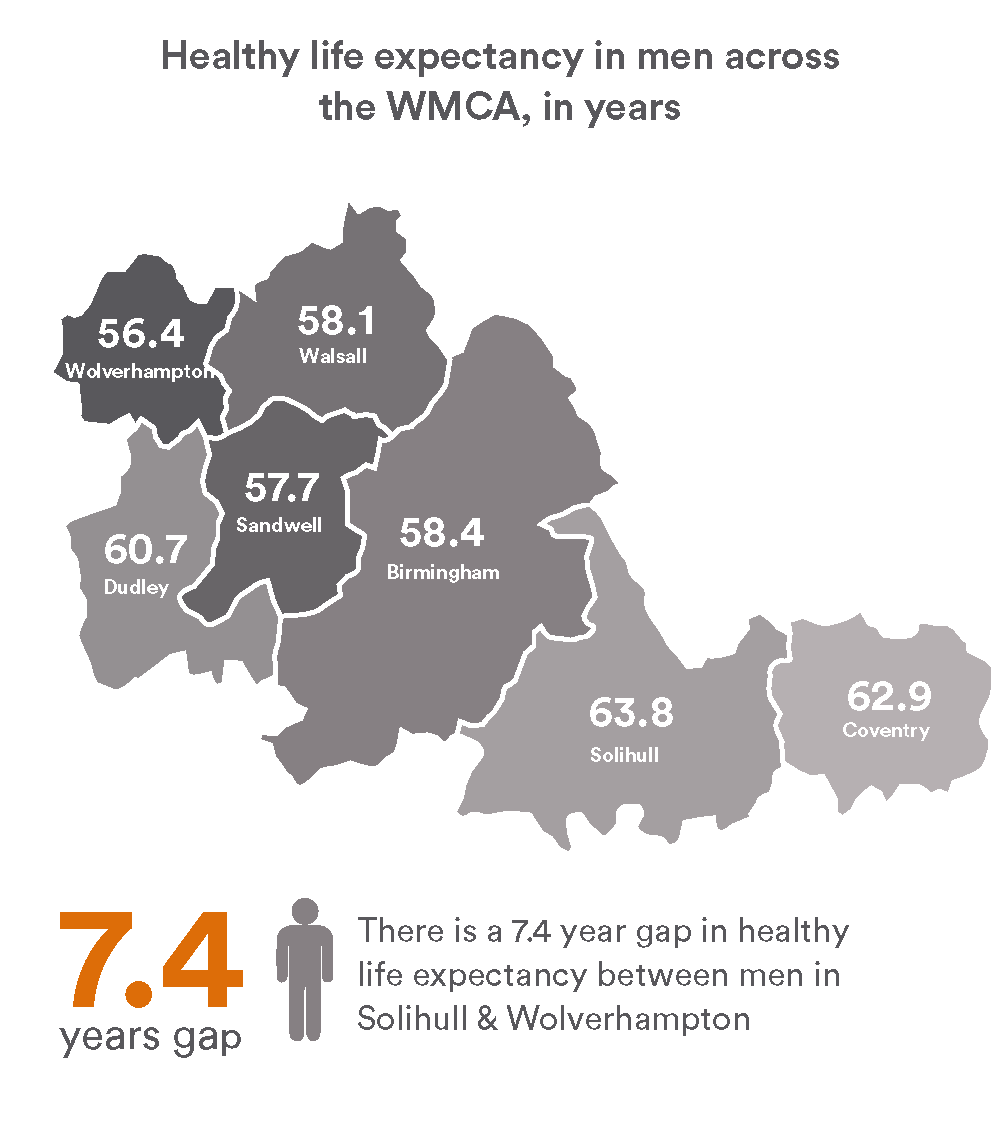
Female Life Expectancy
What does the data show?
This shows how old an average women might expect to live in good health, in a given area.
Where is the data from?
Healthy life expectancies were calculated based on 2009 to 2013 data, and were published by ONS in 2015.
What is it measured in?
Average age ranges a woman might expect to live in good health in a given area.
Map Key
Healthy life expectancy age
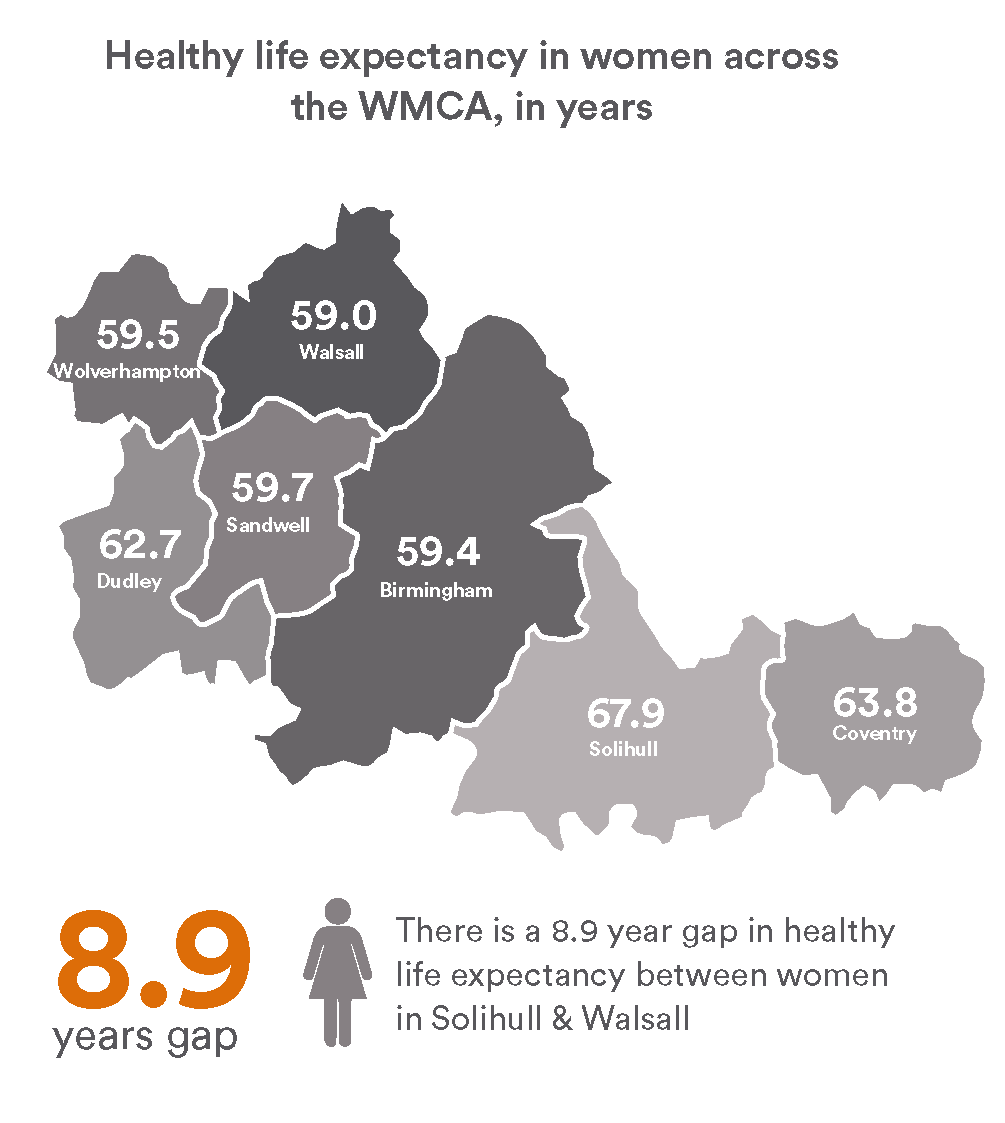
The impact that transport has on health and wellbeing
Map Key
Bus Routes
Rail Routes
Tram Routes
Transport schemes or programmes can have the greatest impact when they are designed to have a positive influence on many of these. Understanding these links helps to prioritise interventions that will have the greatest impact and maximise the benefits of investments to improve health through transport.
Not everyone benefits equally from the same intervention. There are groups of people or areas within the West Midlands where there is a greater potential to improve health and wellbeing. The benefits of transport schemes can also be maximised when they are designed to reduce health inequalities and are targeted at these areas or groups.
